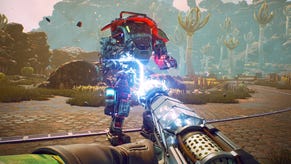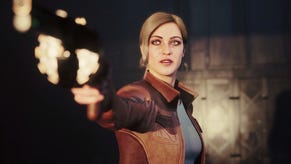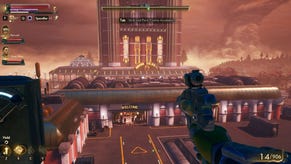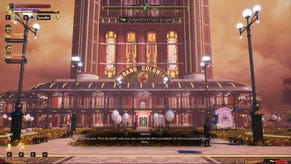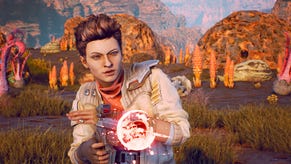The Outer Worlds Makes Conversation As Powerful as Combat
There's a variety of way to tackle your problems in Obsidian's The Outer Worlds.
This article first appeared on USgamer, a partner publication of VG247. Some content, such as this article, has been migrated to VG247 for posterity after USgamer's closure - but it has not been edited or further vetted by the VG247 team.
At E3 2019 during its press conference, Bethesda Softworks announced part of its plan to improve on Fallout 76 following its rough launch. To many, that plan looked like, "Put all the stuff you expect in a Fallout game into Fallout 76," which isn't a bad place to start. Fallout, from the beginning, has been a series about choices and consequences. The first Fallout was the kind of game where there was no single right choice, it thrived in the grey of its fictional reality. Part of the reason I don't enjoy Fallout 3 or 4 as much is I feel those games do something else well, but in the systemic complexity and presentation, they've lost some of the original Fallout spark.
At E3, there was another developer showing off a game that represents the direction I wish Fallout had gone. Obsidian Entertainment showcased The Outer Worlds in a theater presentation, aiming to show players all the choices available to them in their latest RPG. This focus of player options makes sense, given that the folks behind The Outer Worlds—Tim Cain and Leonard Boyarsky—were members of the development team on the original Fallout.
The Outer Worlds sends you to the outermost reaches of the galaxy, a frontier owned and controlled by massive megacorporation Halcyon Holdings. Awoken from cryosleep, it's up to you to figure out who you want to be: hero, villain, rogue, or law-abiding citizen. The E3 demo begins in the town of Fallbrook, a throwback to the rustic old West frontier towns you're familiar with in movies and television, albeit with a science fiction spin to it.
It's astonishing how good The Outer Worlds looked in the demo; there's definitely a little of the modern Fallout look with blank-eyed NPCs talking directly to the first-person camera, but the animation was surprisingly good and the world itself looks fantastic. The opening section in the town itself is within a cave, with crags above and hanging light preventing the town from being blanketed in complete darkness. It's definitely the kind of presentation that requires a first- or third-person camera, and not the isometric viewpoint of Obsidian's Pillars of Eternity 2 or Tyranny.
"One of the things that happened when we made the original Fallout was that I decided that I didn't want to go first-person, because the technology wasn't there," says The Outer Worlds co-director Leonard Boyarsky when I ask why Obsidian went with a first-person viewpoint, instead of the overhead presentation the developer is generally known for. "I wanted a certain amount of artistic fidelity, so we went top-down isometric. I was jealous when Bethesda was able to go first-person because the technology had arrived. There was so much more that I wanted to do with the art that was hard to get into when the sprites were like [gestures] that big. It's so much more immersive when you're in first-person."
In the demo, your team is in Fallbrook trying to make a little bit of money to go to nicer climates. Local leader Catherine Malin is willing to help you in that respect, if you help her first. She wants a regional meat mangate, Clive Lumbergh, gone so she can take over his business. Clive runs a factory on the edge of town where they make boarst, an unsettling meal made from the cystypig, a cancerous creation based on the classic swine. She doesn't care how you remove Clive from the equation, merely that you do. In the conversation, you're presented with the classic Fallout dialog options, with responses requiring specific skills like Charm and Intimidate clearly marked. You'll also find that your companions—the pirate doctor Ellie and big-game hunter Nyoka in this case—will actually interject in conversations if they have something worthwhile to say. In fact, they're pretty talkative all around, even conversing amongst themselves.
In between the town and the factory, Obsidian showed off some of the game's combat. Lifted largely from Fallout's VATS, The Outer Worlds has Tactical Time Dilation, which slows down time. This gives you the chance to look at an enemy's stats or aim at specific body parts. Like Fallout, there's a third-person slow-motion viewpoint of particularly brutal hits. Unlike Fallout, there doesn't seem to be visible chance-to-hit percentage on enemies. Instead, targeting certain body parts gives an indicator of the outcome: targeting an arm reads "Maim," the head says "Blind," the legs "Cripple," and the chest is "Execute." Tactical Time Dilation is also not an infinite resources, with a bar on the target reticle slowly counting down.

Overall though, combat wasn't a huge part of this demo. Instead, once you reach the factory, Obsidian wanted to highlight the potential options for infiltration available to the player. You could shoot your way in, or there's a hidden sewer entrance if your Lockpicking skill is high enough. Instead, the demo had the player getting in through the front door with a combination of disguises and dialog. With an item called the Holographic Shroud, the player is able to project a guard's uniform on themselves. From there, it's a matter of talking your way through, whether that's through normal dialog options, or skills like Lie, Persuade, and Intimidate. For Obsidian, having various options is the primary focus.
"Our basic rule for main story arc stuff is you have to be able to solve it at least three ways: through fighting, stealthing, or talking. That's not all, but that's a bare minimum," says Boyarsky. "Side quests have a variety of those. From there, it's 'what does the story support, what does the game support?' When people are playing it and testing it, they'll say, 'Well I really wanted to do this. Why couldn't I do that?' Well, let's see if we can make it so that you can do that."
Making sure each quest and sidequest has a wide variety of ways to tackle it requires a lot of iteration. The designers start with general idea for each quest, and then bring that to the writers and level designers, letting them play around a bit. "We're not arrogant enough to think that only we have the best ideas that should go into the game. It's really fun ponting people in a direction and seeing what they come up with. And when you have a bunch of creative people together like that, it just really evolves in very interesting directions," Boyarsky explains. Working your way through the factory in the demo offered chances to hack the security system to turn against the guards and convince a mechanical sentry that it should leave you alone, lest it be sent for repairs.
The Holographic Shroud isn't invincible and infallible though. Every time someone challenges your disguise, it loses a charge, making further disguise checks much harder. You can refill a charge by successfully using your dialog skills to convince enemies that you are one of them. All told, talking your way out of problems seemed like the way to go, rather than fighting. Guns are powerful, but words might be more so. Still, fighting everyone is a valid way to live.

"We're always—especially me, because I'm in charge of the writing—about the story and the writing. One of the ways we try to delve into these things is to create characters that you really want to talk to, that have fascinating things to tell you about. But that's just a facet of all the choices you can make in the game, whether you want to focus on the dialog or not," replies Boyarsky when I ask about strength of conversational play in the demo. "You can very well play this game as a stealth character or a combat character who doesn't do a lot of discussion with people. It is possible to kill everybody in this game; you won't get a lot of side quests that way, but you can complete the main story arc. There is one person you can't kill until near the very end of the game, but other than that, everybody is fair game."
The demo ended with the player meeting Clive Lumbergh himself. You have the choice to kill Clive, or you can let him know that Catherine sent you, prompting a counter-offer from him. (You could've also sabotaged the factory without ever meeting him.) Instead of money, Clive offers a lifetime supply of boarst, which is honestly disgusting, but might be useful in terms of ongoing survival. Either way, the choice is yours.
The Outer Worlds feels like it shaping up to be a fantastic RPG, but players should be cautioned that it's more about depth than breadth. This is not a huge, 60-100 hour journey for the player to undertake. Instead, Boyarsky says The Outer Worlds is shorter experience. The length comes from returning to the game and trying different options or character builds.
"We started this before the Microsoft acquisition. We're on a smaller budget, smaller time frame; we wanted to work within that budget and schedule to make sure that we could deliver a polished game that doesn't feel like it's unfinished," he says. "I think the cool thing about it is that people right now at playing the game internally and almost all of them are immediately turning around and playing it again with a different build. There's different factions in the game, you can play them off each other. There's a lot of variety. Some of these longer games, you get to the end of them, you think, 'I gotta take a break before I can possibly even think about going back to that.' This one, it's so much fun from beginning to end."

For Boyarsky, The Outer Worlds was the perfect game to do because he and fellow colleague Tim Cain had done Fallout together, but never really a title that was pure science fiction. "We did our version of fantasy with Arcanum. Science fiction is one of my favorite genres and the fact that we've never made a science fiction game seemed like a horrible oversight," he says. It's also a chance for him to fully step into the role of director, handling the vision for The Outer Worlds instead of working on a ground level.
"When I did Fallout and Arcanum, I was doing a lot of on-the-ground stuff as well. Art, animation, concept, writing. I still do some writing, and I did one or two portraits in this game, I worked with my art director to talk about what the game should feel and look like. Arcanum was a very small team, so I was doing all kinds of things," he tells me. "In this one, I'm really directing and editing, making sure the game is going in the direction we want it to go. But I'm not in there doing a lot of the day-to-day work. It's nice to be in there and do that stuff, but at a certain point if you're making a game this big, you have to make a choice. Do I want to be able to shape what the whole game is? Or do I want to make some models and texture maps, or write five characters? It's a trade off."
The Outer Worlds is coming to PlayStation 4, Xbox One, and PC (via Epic Games Store) on October 25, 2019. And if it takes off, this is just the beginning for the series. Boyarsky rarely gets the chance to revisit the worlds he's been a part of, but when I ask if he's liked the chance to build upon this first game, he tells me, "I'd love to. Let's hope I get that opportunity."




